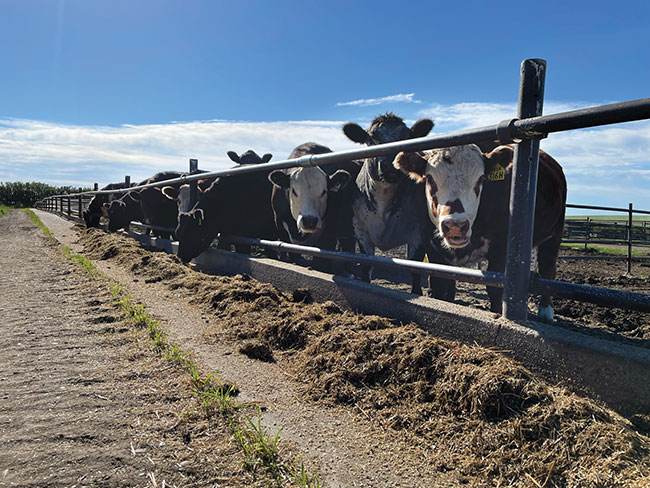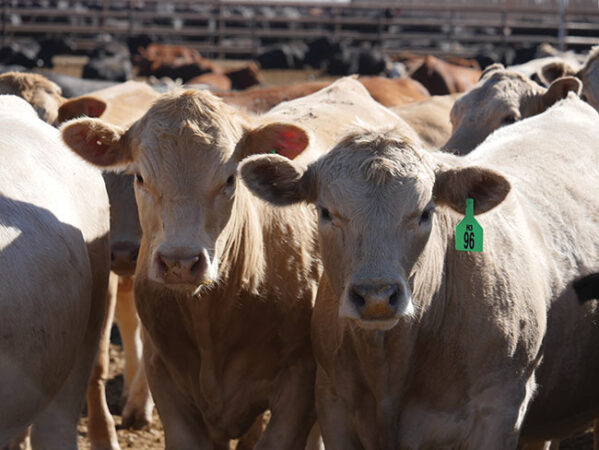
Features
Business
Where’s the beef?
By Richard Kamchen
Canada’s beef operations are on the decline. How are farmers coping?
 A group of cows in Alberta. Known by most as the cattle capital of Canada, Alberta led all provinces in terms of cow-calf declines last year.
All images courtesy of the Government of Alberta.
A group of cows in Alberta. Known by most as the cattle capital of Canada, Alberta led all provinces in terms of cow-calf declines last year.
All images courtesy of the Government of Alberta. Canada’s beef cattle sector badly needs an injection of multiple profitable years to put the brakes on its downward spiral.
The number of cows on cow-calf operations are in decline, and so too are the amount of beef farms.
For July 1, 2023, Statistics Canada reported the number of head on beef operations fell to 10.302 million, down 1.6 per cent from the same time last year. The number of beef cows on cow-calf operations declined 1.8 per cent year-on-year to 3.112 million head.
Meanwhile, the most recent Ag Census revealed the number of farms reporting beef cattle in 2021 at 54,517, a marginal 1.3 per cent increase from 2016, and a rare uptick during a decades’ long nosedive. In 2011, over 61,000 farms reported beef cattle. A decade before that? Nearly 91,000, which was a significant drop from the 103,675 farms reported in the previous census of 1996.
Beef sector declines are also evident south of the border. USDA’s July estimates pegged the number of U.S. beef cows at 29.4 million head, down three per cent from last year. The January 2023 figure of 28.9 million was the lowest level since 1962. USDA also estimated the country’s calf crop at 33.8 million head, down two per cent from 2022.
“The U.S. cattle cycle is going through a liquidation phase that has been amplified by the drought conditions,” explains Brenna Grant, executive director of Canfax and Canfax Research Services.
Poor profits
Dry weather, aging farm operators, and supply chain disruptions are obvious culprits behind Canada’s beef cattle woes, but huge costs and poor prices are undeniably hurting producers.
Alberta led all provinces with a 155,200 head decline as cow-calf numbers there fell to 2.671 million as of Jan. 1, 2023.
Ryan Copithorne, a fourth-generation rancher from Jumping Pound, Alberta, says it comes down to profits, or lack thereof.
“For the past seven years, the average producer’s fully loaded cost of producing a calf was around $900 to $1100. Calf prices of $2.00 per head provided only $100 per calf margins, meaning a 250-cow operator would only generate $25,000 profit,” he says.
Taking into account the costs of raising an animal just worsens the business case.
“Consider 10 acres per cow for that 250-cow operator at $3,500 per acre, or $8.75 million worth of land to carry a commodity that yields a mere $25,000 per year in profits,” Copithorne says. “Add in cost of equipment, infrastructure, labour and the total investment is easily over $10 million for the ranch, and another $500,000 to buy the cows for a measly $25,000 per year return.”
Copithorne says commodity prices and weather make the industry extremely risky, and that the rewards seldom cover the risks.
“We need more affordable risk management programs tailored to ranchers specifically. The AgriStability program is not a hit in the ranching community. Livestock Price Insurance is a good program; we just need to have the premium costs incentivized like they do in the U.S.,” he says.
Grain drain
The difficulty in turning a profit has farmers looking at other commodities to produce.
Thanks to inflation increasing input costs drastically, even with calves at $3 per pound, or about $1,650 per calf, profit margins pale, especially next to crops like canola, Copithorne says.
“Compare revenues: 40 bushels canola at $17 per bushel equals $680 per acre gross revenue, versus 10 acres per cow year-round, $1,650 per calf times a 90 per cent wean rate for $150 per acre gross cattle revenue. It’s not even comparable.”
The gap between crop production and beef farming has widened for over a decade, and the latest ag census reported that in 2021, grain and oilseed farms accounted for 34.3 per cent of total farms, but beef and feedlots only 21 per cent.
“The ease of grain farmers to expand and gain economies of size versus cattle operations has also made it tough for cow-calf producers,” says Brian Perillat, agribusiness specialist with More Than Just Feed.
Specialization in primary agriculture — either larger grain farms or large cattle operations — is another issue.
“This has resulted in less mixed farms, and many farms decide to sell the cows and turn the land to grain production,” says Perillat.
As well, the profitability in the grain industry and technology to grow crops on more marginal land has caused loss of forage land from the cattle industry.
While there are some programs to promote grassland management, their funding are relatively small, and limited advancements in forage production and grass land productivity are just additional factors negative to the cattle sector, Perillat says.
Grant believes that in order to level the playing field, government should come up with a mechanism that puts money in farmers’ jeans for protecting things like wildlife habitat, native grasslands, and grasslands in general.
Copithorne agrees: “Allowing ranchers to be compensated for the carbon they sequester, the wildlife they maintain, and the biodiversity they protect with grasslands could bring that needed prosperity to keep them in business. We as a society need to prioritize the significance of grasslands as a vital ecosystem and reward or compensate those that preserve it.”

Another group of cattle in Alberta, where some farmers are opting to either sell off cows and convert entirely to grain production, or opt for mixed farming.
Succession
Better succession planning could also benefit the industry, but it’s a tough sell.
“Succession can be tough for ranches as the next generation doesn’t want the work and be tied down year-round relative to what they are paid to do that,” says Perillat.
Beef cattle’s biggest problem is a lack of succession planning, Copithorne says. StatsCan’s last ag census revealed the proportion of farms in Canada reporting a succession plan stood at a mere 12 per cent, and that the largest share of those – 44.5 per cent – were grain and oilseed farms. StatsCan also reported 22 per cent of farmers only had a verbal succession plan, and 66 per cent none at all.
Low margins and a seven-day-a-week work schedule has the next generation saying “no thanks” and moving away for better opportunities, says Copithorne. Beef cattle’s image problem is also hurting succession as cows get blamed for contributing significantly to climate change, he adds.
Cow-calf turnaround
Turning the sector’s declines around won’t happen overnight, and will require a string of very profitable years at the cow-calf operation level, says Perillat.
“It takes really good profits and big shifts in grain profitability and land use to see growth in cow numbers,” he says.
At best, the number of cows can only maintain over the short-to-medium term, according to Perillat, who has a hard time seeing much growth happening during that period.
Grant indicates it could take years before the number of cows on cow-calf operations are likely to rise. “From the time the price signal is received to expand, it takes two to three years before female retention results in more beef available to the consumer,” she says.
Copithorne estimates itll take two to three years of strong calf prices before ranchers can get excited about expansion. “The last big cattle rally in 2014 only lasted just over a year and then prices collapsed again. People don’t believe the prices can stay high for long. They need to be convinced that high prices are here to stay before they will really dig in again and expand.”
Beef farms’ downward trend
Although beef farm numbers have been in decline, Grant says a downward trend goes back over the last several decades for many agricultural commodities.
But for beef farmers specifically, she points out inflation is eating away at the purchasing power of producers. “With small margins per head, more head are needed to support a family. Hence, the drive to consolidation,” says Grant.
“I would guess the number of cattle operations would trend lower, similar to almost all large-scale primary agriculture sectors,” adds Perillat.
Copithorne says that barring a two-to-three-year profitability momentum shift, beef farms’ downward trend will continue.
Succession issues also must be resolved, he says: “Don’t forget the age of the farmer. Most of these farms are going to turn over in the next few decades. We need some solutions, or the auction catalogs could get pretty thick.”
Print this page